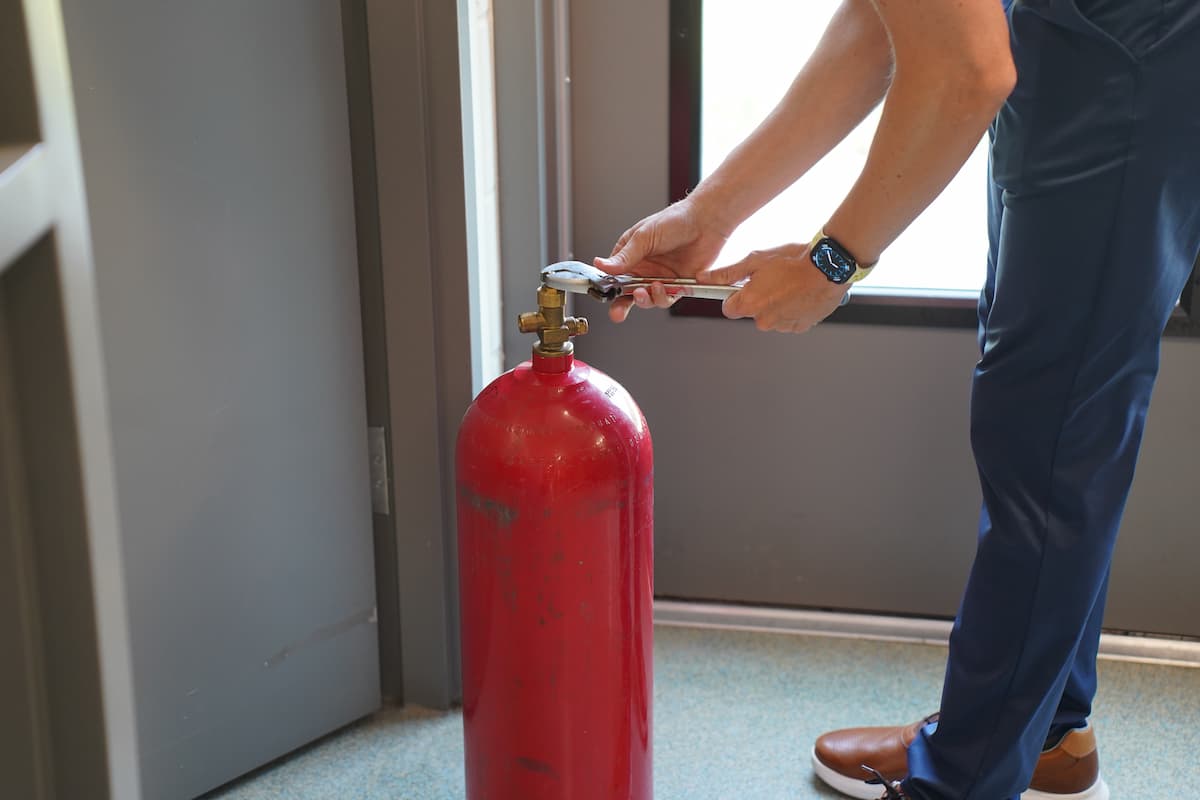Lincoln University Aquaculture Program Aids Police Investigation
Office of Communications and Marketing
Young Hall
820 Chestnut Street
Jefferson City, MO 65101
 Chesterfield Police brought a confiscated canister to LU’s aquaculture lab in the Dickinson Research Center to test for Nitrous Oxide.
Chesterfield Police brought a confiscated canister to LU’s aquaculture lab in the Dickinson Research Center to test for Nitrous Oxide.
Lincoln University of Missouri’s (LU) Aquaculture Program is no stranger to scientific testing. The program dives deep into aquatic research, working to elevate aquaculture producers through various channels.
In August, however, the program entered unfamiliar waters when researchers aided Chesterfield Police with a felony investigation.
The unexpected collaboration arose when Shimadzu, an industrial and testing equipment company, reached out to Dr. Dallas Flickinger, an assistant professor of aquaculture and aquaculture program coordinator for Lincoln.
Shimadzu previously supplied Flickinger with a gas analyzer to use in his research on gas exchange and emissions in ponds.
 Shimadzu tech support scientist Justin Lafser explains the test he’s running to Chesterfield police officer Owen Stoehner.
Shimadzu tech support scientist Justin Lafser explains the test he’s running to Chesterfield police officer Owen Stoehner.
Jared Downard, a Shimadzu sales representative, told Flickinger the Chesterfield Police Department needed to test a confiscated gas canister for nitrous oxide in relation to an ongoing felony drug investigation.
However, nobody nearby possessed the equipment necessary to do so — nobody except for Lincoln University.
With Flickinger and the rest of the aquaculture team’s blessings, Chesterfield police officers Ryan Broeker and Owen Stoehner drove to Jefferson City to use Flickinger’s gas analyzer.
Standing outside the aquaculture lab in LU’s Dickinson Research Center, Broeker explained that a group of dealers were selling nitrous Oxide in balloons to attendees at concerts.
Nitrous oxide, or laughing gas, is commonly used as an anesthetic for surgery and dentistry. While the gas isn’t a controlled substance, distributing it as a recreational drug is a criminal act.
“It’s the intent. It’s what you’re doing with it,” Broeker said. “If a carpenter has a screwdriver, he’s doing carpentry. If a shoplifter has a screwdriver, he’s using it for something else.”
 Lincoln University’s aquaculture gas analyzer, purchased from Shimadzu, can test samples for the presence of various gases, including Nitrous Oxide.
Lincoln University’s aquaculture gas analyzer, purchased from Shimadzu, can test samples for the presence of various gases, including Nitrous Oxide.
Broeker said the dealers were following a band as they traveled to different concert venues — even crossing state lines — prompting the band to contact law enforcement.
When Broeker and Stoehner arrived at an event to investigate, they saw the dealers selling balloons to people in the parking lot and attempted to stop them for questioning.
Broeker said the suspects released the balloons, which flew away, and fled on foot.
The officers chased down and arrested two of the suspects and secured the canister they were using to fill balloons.
“Now we just have to make sure it’s nitrous oxide," Broeker said. "When I talked to the guy, he was like, ‘Hey man, it’ll knock you down.’ It was very roundabout. He didn’t say what it was because that would be admitting guilt. So, the prosecutors can’t go forward unless they know what it is.”
Broeker and Stoehner watched as Justin Lafser, a Shimadzu tech support scientist, filled a vial with gas from the confiscated canister, then analyzed the vial using Flickinger’s machine.
“Definitely nitrous!” Lafser yelled from the lab a few minutes later.
 LU graduate students took the chance to learn from Shimadzu tech support scientist Justin Lafser how the gas analyzer works.
LU graduate students took the chance to learn from Shimadzu tech support scientist Justin Lafser how the gas analyzer works.
Lafser showed Broeker and Stoehner the results, revealing the nitrous oxide levels had “flat-topped,” meaning they were so high they peaked off-screen.
With definitive proof of the canister’s contents, the officers returned to Chesterfield to give their evidence to prosecutors.
In addition to aiding a police investigation, the test also served as a training opportunity. Several graduate students crowded into the aquaculture lab to watch as Lafser ran tests. He even ran additional tests after Broeker and Stoehner left, explaining the testing process and demonstrating how the machine worked.
“This is so cool,” Flickinger said. “It’s good for us to see this in action.”
Click here to learn more about Lincoln University’s Aquaculture Program.
